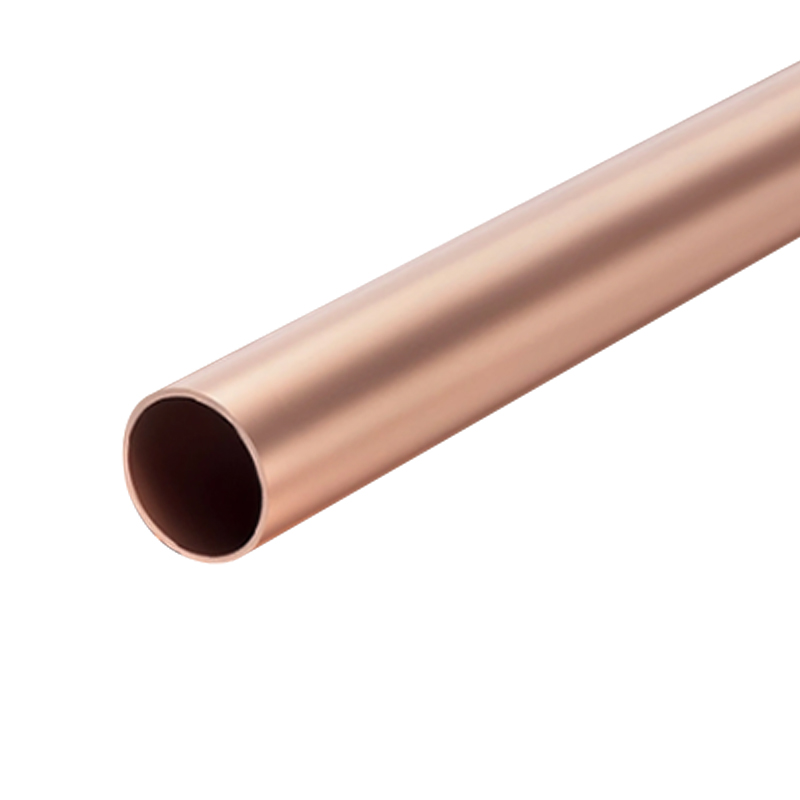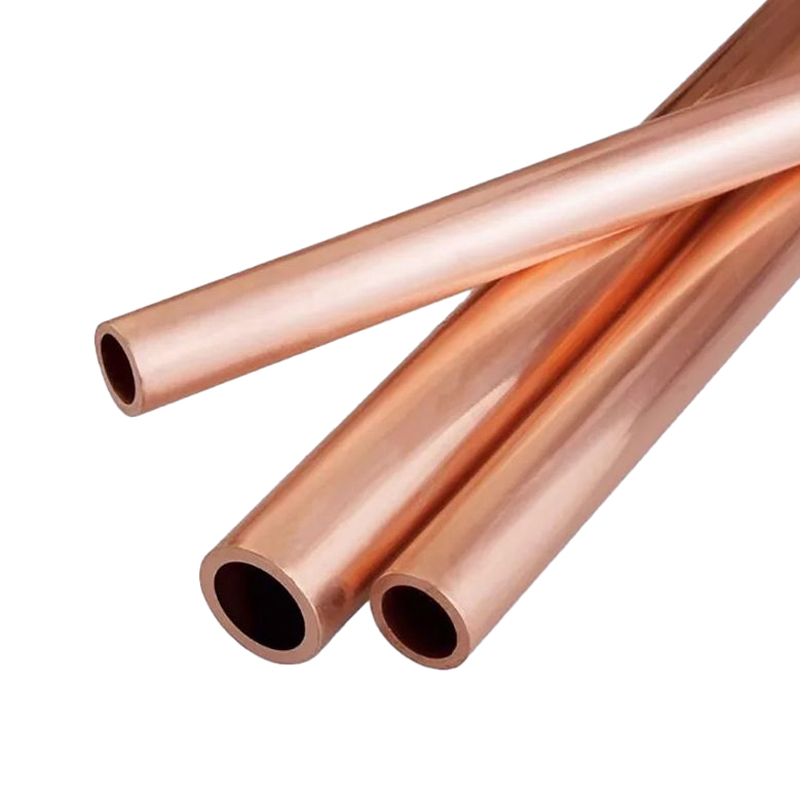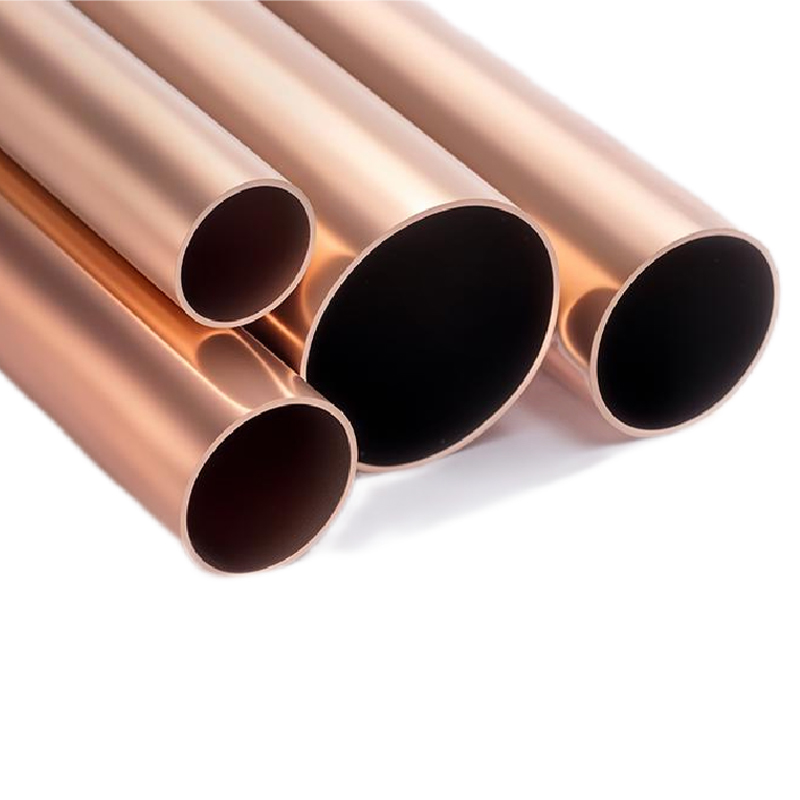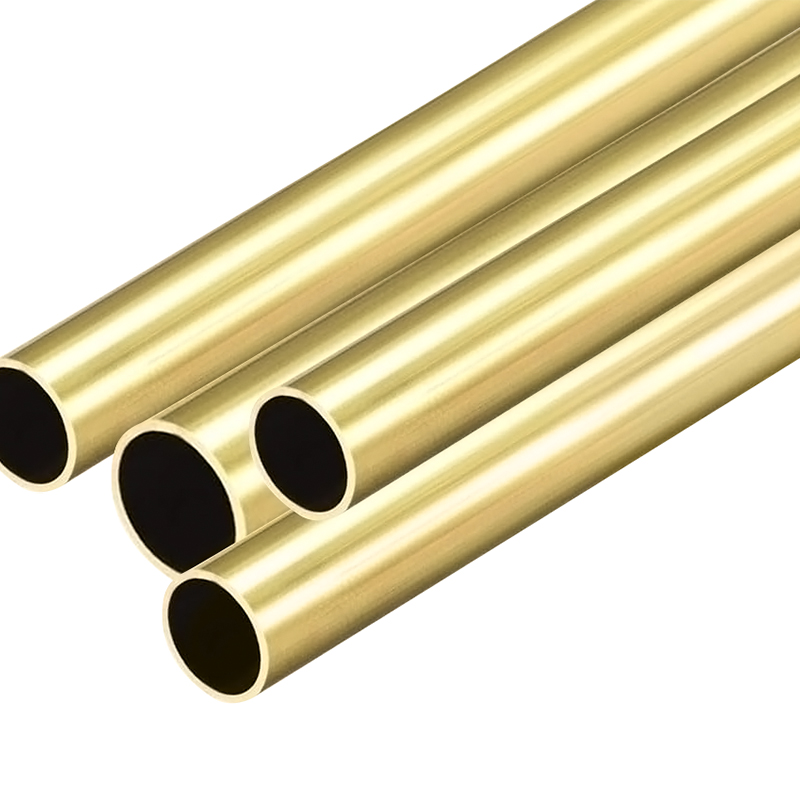Copper Tube is made of high-purity copper material with a copper content of not less than 99.9%. The main material codes are T11050 and C12200(DHP), and it has physical and chemical properties. The product has ductility and is easy to process into various complex shapes. It is suitable for various forming processes such as welding and tube bending. It is widely used in building hot and cold water systems, medical gas transmission, refrigeration equipment condensers, and low-temperature transportation of oxygen production equipment. Copper itself has thermal conductivity, which makes it particularly outstanding in the heat exchange and refrigeration industries. At the same time, it has good corrosion resistance and can maintain long-term stable use in complex environments. The product specifications are rich, with an outer diameter range of 1.8mm to 80mm and a wall thickness of 0.3mm to 12mm. It can be customized according to customer needs to meet the personalized requirements of different industries.
ABOUT US
30+YEARS OF
EXPERIENCE
About Us
A Reliable Partner of the Copper Tube Industry
Zhejiang Jingliang Copper-Tube Products Co., Ltd established in 1994, is China Corrosion Resistance Copper Tube Manufacturers and Custom Corrosion Resistance Copper Tube Factory, has been deeply involved in the copper tube industry for over three decades. The company primarily produce various specifications of products such as copper tubes, brass tubes, copper square tubes, fin copper tubes, copper capillary tubes, condenser copper tubes, copper evaporator tubes, and conductive rods, which are of quality and have earned the trust and acclaim of customers both domestically and internationally.
Wide Applications:
These products are widely used in various fields including air conditioning, refrigeration, heat exchange, sanitary ware, automotive, machinery, electric furnaces, and chemical industries.
Convenient Transportation:
Strategically located in Tangpu Town, renowned as the “home of copper tubes” in East China. Our company enjoys a prime location, adjacent to the Shangsan Expressway and National Highway 104, and is conveniently situated just over 70 kilometers from Hangzhou and Ningbo, ensuring easy accessibility and a business position.
Strong Financial Resources:
With its strong financial resources and advanced copper tube processing technology, our company holds an advantageous position in market share, brand value, technological content, and product quality, becoming a preferred supplier for many listed groups.
Large Scale Production:
The company occupies an area of over 20,000 square meters, with a construction area of 12,800 square meters. In 2022, our annual production exceeded 7,500 tons, with a value output of up to 450 million yuan, demonstrating our strong production capacity and market competitiveness.
Comprehensive Industry Chain:
Jingliang has now developed into a complete industrial chain integrating smelting, extrusion, drawing, precision rolling, and annealing. It has been awarded multiple honors, including "Top Ten Copper Tube Enterprises" and "Leading Taxpayer in the Copper Tube Industry".
Smart Manufacturing:
Jingliang Copper-Tube Products will better integrate the concept of factory construction into its corporate development strategy, insist on refining technology and polishing products more finely, and the future of "intelligent manufacturing".
Genuine Cooperation:
Zhejiang Jingliang Copper-Tube Products Co.,Ltd warmly welcomes friends from all walks of life to visit and offer guidance. We look forward to joining hands with you to create a brilliant future together.
Technical skills
Production Process
- 1、Electrolytic Copper
- 2、Copper Ingots
- 3、Press
- 4、Drawing
- 5、Rolling
- 6、Packaging
Electrolytic copper, produced through electrolytic processes, is a high-purity copper with good electrical conductivity and thermal conductivity, making it an ideal material for manufacturing copper pipes.
This marks the beginning of our production process, which involves the fabrication of electrolytic copper into pure copper or brass ingots according to specific requirements, followed by cutting to facilitate subsequent processing and handling.
In the pressing stage, the cut copper ingots are pressed into thin sheets or tubular shapes, forming the initial tube shape, and the copper ingots are prepared for drawing and rolling.
Drawing is the process of further processing the copper sheets or tubular objects that have been pressed into the required dimensions and shapes. Through drawing, our copper tubes can achieve precise outer diameters and wall thicknesses.
Rolling is the step of further processing the copper tubes after drawing. Through rolling, the copper tubes are rolled into more precise dimensions and shapes to meet the requirements of different applications.
Finally, the copper tubes that have undergone rolling will be packaged and prepared for shipping. We ensure that the packaging is safe and protective to prevent damage during transportation.
News
-
In the world of heat exchangers, air conditioning systems, refrigeration units, and other thermal management applications, the choice of materials for the tubes that facilitate heat transfer is crucial. Copper and aluminum are two of the mo...
READ MORE -
Refrigeration systems are essential in modern-day life, from preserving food and medicine to maintaining the comfort of our homes and workplaces. One of the key components that ensure the efficient operation of these systems is the capillar...
READ MORE -
Subtitle: When the U.S. imposed 50% tariffs on copper tubes triggered a global trade chain restructuring, how did production capacity in Southeast Asia and Mexico surge by 46.3% within a year? This policy-driven supply chain migration is re...
READ MORE
Industry knowledge
What are the main chemical factors that affect the corrosion resistance of copper tubes?
The importance of the corrosion resistance of copper tubes
The corrosion resistance of copper tubes is an important indicator to measure their quality and application value. copper tubes with poor corrosion resistance are prone to pitting, crevice corrosion, stress corrosion cracking and other problems, leading to pipeline leakage, equipment failure and even safety accidents, seriously affecting the normal operation and maintenance cost of industrial systems.
Main chemical factors and their influencing mechanisms
Chemical composition of water quality
When copper tubes are used in water systems, the components such as dissolved oxygen, chloride ions, sulfides, carbonates and pH value in the water directly affect their corrosion behavior.
Chloride ions (Cl⁻): Chloride ions are one of the main promoters of copper pipe corrosion. High concentrations of chloride ions can destroy the protective oxide film on the surface of copper, leading to pitting and crevice corrosion, and even rapid perforation in severe cases. Zhejiang Jingliang focuses on enhancing the resistance of copper tubes to chloride ions in product design and surface treatment to ensure the long-term stability of products in chlorine-containing environments.
Dissolved oxygen: The presence of oxygen promotes the oxidation process of copper. The higher the concentration of dissolved oxygen, the faster the corrosion rate is usually. Zhejiang Jingliang optimizes the internal structure of the pipe by strictly controlling the production process, and improves the tolerance of copper tubes to oxidative corrosion.
pH value: Acidic or strongly alkaline environments may aggravate the corrosion of copper tubes. Acidic media accelerate the dissolution of copper, while alkaline environments may cause hydroxide deposition and affect heat transfer performance. Zhejiang Jingliang develops a variety of acid- and alkali-resistant copper tubes for different application environments to meet the diverse needs of customers.
Effects of sulfides and sulfates
Common sulfides in industrial environments react chemically with copper to form copper sulfides, destroying the dense oxide film of copper and promoting corrosion. Sulfur-containing compounds such as sulfates can also affect the surface structure of copper tubes and reduce their corrosion resistance. Zhejiang Jingliang attaches great importance to controlling harmful impurities in the material selection and production process to improve the purity and chemical stability of products.
Salt compounds
In addition to chloride ions, corrosion resistance copper tubes are also corroded by salts such as sodium chloride and sodium sulfate in marine and salt spray environments. Zhejiang Jingliang products undergo strict salt spray tests before leaving the factory to ensure that they exhibit excellent corrosion resistance under harsh salt spray conditions.
Organic acids and corrosive gases
Industrial gases such as sulfur dioxide (SO₂), carbon dioxide (CO₂) and volatile organic acids can cause acidic corrosion on the surface of corrosion resistance copper tubes, especially in the chemical industry and electric furnace industry. Zhejiang Jingliang improves the resistance of copper tubes to these corrosive media by precisely controlling the alloy composition and surface treatment technology.
Electrochemical factors
During the use of corrosion resistance copper tubes, potential difference and electrochemical reaction are also important factors affecting corrosion, especially in multi-metal contact and wet environments. Zhejiang Jingliang uses advanced detection and simulation technology to optimize the electrochemical properties of copper tubes and reduce the risk of galvanic corrosion.
How to improve the corrosion resistance of copper tube surface treatment technology
Challenges and requirements for corrosion resistance of copper tubes
In actual applications, copper tubes are often exposed to chloride-containing water environments, industrial acid and alkali media, high temperature and humid environments, and even microbial erosion environments, which may cause different types of corrosion, such as pitting, crevice corrosion, stress corrosion, etc., which seriously affect the service life and safety of copper tubes. Especially in the marine, chemical and power industries, higher requirements are placed on the corrosion resistance of copper tubes.
The core role of surface treatment technology
The goal of copper tube surface treatment technology is to form a dense and stable protective film on the surface of the copper tube through physical, chemical or electrochemical means, effectively blocking the contact between the corrosive medium and the copper matrix, and delaying or stopping the corrosion process. The main surface treatment methods include:
Chemical plating
Chemical nickel plating, chemical silver plating and other technologies can form a uniform and dense alloy layer on the surface of the copper tube, significantly improving the anti-oxidation and corrosion resistance of the copper tube. Zhejiang Jingliang optimizes the chemical plating process to achieve precise control of the thickness and uniformity of the plating layer, thereby enhancing the surface protection ability of the product.
Electroplating treatment
The electroplating process is a traditional and effective surface treatment method. Through the electrolytic process, an anti-corrosion metal layer (such as nickel and chromium) is deposited on the surface of the copper tube, which not only improves the corrosion resistance, but also improves the mechanical properties. Zhejiang Jingliang uses an automated electroplating line to ensure that the plating is stable and has strong adhesion.
Oxide film treatment
The oxide film on the surface of the corrosion resistance copper tube has a natural protective effect, but its film layer is thin and easily affected by the environment. Zhejiang Jingliang uses advanced technologies such as anodizing to form a dense and wear-resistant oxide protective layer, which effectively improves the corrosion resistance of copper tubes, especially in high humidity environments.
Coating technology
Using organic coatings, anti-corrosion paints and other methods, an isolation layer is formed on the surface of the corrosion resistance copper tube to effectively resist chemical corrosion and mechanical wear. Zhejiang Jingliang has developed a variety of functional coatings for different application scenarios to meet the personalized needs of air conditioners, heat exchangers and other fields.
Surface nano-treatment
With the development of nanotechnology, Zhejiang Jingliang has introduced nano-coatings and surface modification technologies to improve the density and self-healing ability of the copper tube surface, and further enhance the corrosion resistance of copper tubes in extreme environments.
What are the differences in the effects of different types of corrosion on copper tubes?
Copper tubes are an indispensable and important material in industrial production and life. They are widely used in air conditioning and refrigeration, heat exchange, automobile manufacturing, electric furnaces and chemical industries. Since its establishment in 1994, Zhejiang Jingliang Copper-Tube Products Co., Ltd. has been deeply involved in the copper tube industry for more than 30 years and has a complete industrial chain and advanced technology. Faced with complex and changing use environments, the corrosion resistance of copper tubes has become a key indicator of product performance. Different types of corrosion have significant differences in their effects on copper tubes. Understanding their mechanisms and performance is particularly important for improving product quality and service life.
General Corrosion
General corrosion is a form of corrosion in which the surface material of the copper pipe is uniformly affected by the corrosive medium, resulting in a reduction in the overall metal thickness. It is characterized by a relatively balanced corrosion rate, which is manifested as the copper pipe surface gradually becoming thinner, duller in color, and losing its luster. Although general corrosion will not immediately cause pipe perforation, the long-term effect will weaken the mechanical strength of the copper pipe.
Zhejiang Jingliang uses high-purity copper materials and optimized alloy composition in design and manufacturing to effectively slow down the process of general corrosion. At the same time, the company uses scientific surface treatment technology to enhance the stability of the oxide film on the surface of the copper pipe and effectively extend the service life of the product.
Pitting Corrosion
Pitting is a localized and extremely destructive type of corrosion, manifested as corrosion pits of varying sizes on the surface of the corrosion resistance copper pipe. This type of corrosion is extremely hidden, with deep and small corrosion pits that are often difficult to detect with the naked eye, but they will quickly penetrate the copper pipe wall, causing pipeline leakage or even rupture.
Pitting corrosion often occurs in environments with high chloride ion content, such as seawater and salt water. Zhejiang Jingliang pays special attention to the impact of chloride ions on products, and adopts advanced alloy formulas and surface treatment technologies to significantly improve the resistance of copper tubes to pitting corrosion. In addition, the company introduces intelligent detection equipment to monitor product quality in real time and reduce the risk of pitting corrosion.
Crevice Corrosion
Crevice corrosion usually occurs in tiny gaps such as the connection between copper tubes and other components, welds, and pipe joints. Due to poor fluid flow in the gap, the oxygen concentration is reduced, forming local cathode and anode areas, which prompts the copper pipe to corrode rapidly locally.
Zhejiang Jingliang optimizes product design, reduces the presence of structural gaps, and adopts special surface treatment processes in key parts to enhance local corrosion resistance and effectively prevent the occurrence of crevice corrosion.
Electrochemical Corrosion
copper tubes are prone to galvanic corrosion in a humid environment, especially when in contact with other metal materials. The potential difference between different metals causes the copper tube to become an anode and is accelerated to corrode. Electrochemical corrosion not only accelerates the loss of copper tubes, but may also affect the stable operation of the overall equipment.
Zhejiang Jingliang reduces the risk of electrochemical corrosion of copper tubes through material selection and process control. The company actively promotes the reasonable isolation technology of dissimilar metals and combines it with the intelligent manufacturing system to achieve efficient protection.
Stress Corrosion Cracking (SCC)
Stress corrosion cracking refers to the cracking of copper tubes under the combined action of mechanical stress and corrosive media. The cracks extend along the grain boundaries or other weak areas, eventually leading to the rupture of the pipeline. SCC is hidden and sudden, which brings serious hidden dangers to industrial production.
Zhejiang Jingliang strictly controls the stress level in the stretching, extrusion and annealing processes, and adopts corrosion-resistant material formulations and surface strengthening technologies to significantly reduce the risk of stress corrosion cracking and ensure the reliability of copper tubes under high load environments.
Microbiologically Influenced Corrosion (MIC)
Microbiological corrosion is corrosion caused by bacteria and microbial metabolites. Microorganisms multiply on the surface of copper tubes to form biofilms, change the chemical properties of the local environment, and promote the corrosion process. MIC is commonly found in hot and humid environments such as water treatment systems and heat exchange equipment.
Zhejiang Jingliang effectively inhibits microbial attachment and growth through material optimization and surface antibacterial treatment, improves the product's ability to resist microbial corrosion, and extends the system's operating life.

 English
English Español
Español




